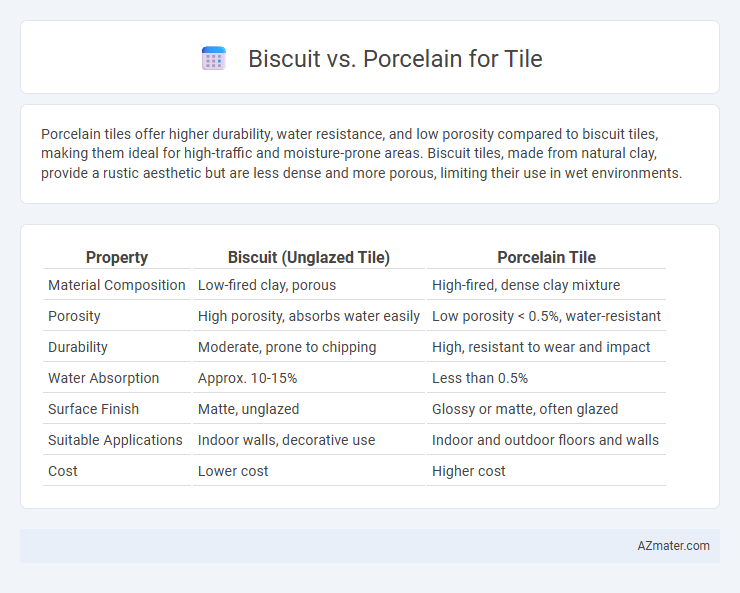Porcelain tiles offer higher durability, water resistance, and low porosity compared to biscuit tiles, making them ideal for high-traffic and moisture-prone areas. Biscuit tiles, made from natural clay, provide a rustic aesthetic but are less dense and more porous, limiting their use in wet environments.
Table of Comparison
| Property | Biscuit (Unglazed Tile) | Porcelain Tile |
|---|---|---|
| Material Composition | Low-fired clay, porous | High-fired, dense clay mixture |
| Porosity | High porosity, absorbs water easily | Low porosity < 0.5%, water-resistant |
| Durability | Moderate, prone to chipping | High, resistant to wear and impact |
| Water Absorption | Approx. 10-15% | Less than 0.5% |
| Surface Finish | Matte, unglazed | Glossy or matte, often glazed |
| Suitable Applications | Indoor walls, decorative use | Indoor and outdoor floors and walls |
| Cost | Lower cost | Higher cost |
Introduction to Biscuit and Porcelain Tiles
Biscuit and porcelain tiles are popular choices in flooring and wall applications, distinguished by their composition and durability. Biscuit tiles, typically unglazed and made from natural clay, offer a rustic and earthy aesthetic with moderate water resistance. Porcelain tiles, crafted from finer clay fired at higher temperatures, provide superior strength, low porosity, and enhanced resistance to stains and moisture, making them ideal for high-traffic and wet areas.
Composition and Manufacturing Process
Biscuit tiles are made from natural clay and minerals, shaped through extrusion or pressing, then fired at lower temperatures, resulting in a porous and less dense structure. Porcelain tiles are composed of fine-grained clay mixtures with silica and feldspar, subjected to high-temperature firing above 1200degC, producing a denser, more vitrified surface with superior hardness. The manufacturing process differences affect durability and water absorption, with porcelain offering enhanced resistance due to its compact composition and intense firing.
Physical Properties Comparison
Biscuits, typically made from a porous, low-density clay material, exhibit lower hardness and water absorption rates compared to porcelain tiles, which are crafted from highly refined clay and undergo higher firing temperatures resulting in greater density and durability. Porcelain tiles demonstrate superior strength, resistance to scratching, and moisture absorption below 0.5%, making them ideal for high-traffic and wet areas, whereas biscuits tend to be more prone to chipping and staining due to their softer, more absorbent nature. The physical properties of porcelain--such as high firing temperature around 1,200degC and vitrification--contribute to its exceptional hardness and longevity in flooring and wall applications.
Durability and Strength Differences
Porcelain tiles exhibit superior durability and strength compared to biscuit tiles due to their higher density and lower porosity, making them highly resistant to wear, moisture, and heavy foot traffic. Biscuit tiles, often made from earthenware clay, are more porous and softer, which limits their suitability for high-traffic or moisture-prone areas. Porcelain's enhanced toughness results from being fired at higher temperatures, ensuring long-lasting performance in both residential and commercial flooring applications.
Water Absorption and Stain Resistance
Porcelain tiles exhibit significantly lower water absorption rates, typically less than 0.5%, compared to biscuit tiles, which can absorb up to 7%. This low water absorption in porcelain makes it highly resistant to stains, moisture damage, and mold growth, ideal for high-traffic and wet areas. Biscuit tiles, with higher porosity, are more susceptible to staining and require sealing to maintain durability and appearance.
Design, Finishes, and Color Options
Porcelain tiles offer a broader range of design possibilities, including intricate patterns and realistic textures that mimic natural stone or wood, while biscuit tiles typically emphasize traditional, simpler aesthetics with smooth, matte surfaces. Porcelain finishes vary widely from polished to textured, enhancing both visual appeal and slip resistance; biscuit tiles usually feature a uniform, matte finish suited for classic or rustic interiors. Color options in porcelain tiles span from vibrant hues to subtle earth tones, providing versatile choices for contemporary designs, whereas biscuit tiles predominantly come in muted, neutral shades that complement vintage or farmhouse styles.
Installation Requirements and Techniques
Biscuit tile installation requires precise alignment tools and a thinner grout line to ensure a seamless, flat surface, often using metal or plastic spacers for accuracy. Porcelain tile installation demands a stronger, more flexible thin-set mortar due to its density and low porosity, with proper substrate preparation crucial for adhesion and preventing cracking. Both types benefit from wet cutting techniques for clean edges, but porcelain tiles typically need specialized saw blades due to their hardness.
Cost Comparison: Biscuit vs Porcelain
Biscuit tiles generally cost less than porcelain tiles, with prices typically ranging from $1 to $5 per square foot for biscuit compared to $3 to $10 per square foot for porcelain. Porcelain tiles offer superior durability and water resistance, which can lead to lower long-term maintenance expenses despite the higher upfront cost. Choosing biscuit tiles may reduce initial installation costs but porcelain is a more cost-effective option over time due to its longevity and minimal upkeep requirements.
Best Applications for Each Tile Type
Biscuit tiles, known for their matte finish and natural look, are best suited for low-traffic areas such as residential walls and decorative backsplashes where warmth and texture enhance the space. Porcelain tiles offer superior durability and water resistance, making them ideal for high-traffic floors, bathrooms, and outdoor applications requiring heavy wear and moisture protection. Selecting biscuit or porcelain tiles depends on balancing aesthetic preferences with functional requirements, optimizing performance in targeted environments.
Maintenance and Longevity Considerations
Porcelain tiles exhibit superior durability and minimal maintenance requirements due to their denser composition and resistance to stains, scratches, and moisture. Biscuit tiles, while aesthetically pleasing with their natural, unglazed finish, are more porous and prone to staining, necessitating regular sealing and careful cleaning. Long-term performance favors porcelain, which maintains its structural integrity and appearance over decades with minimal upkeep.

Infographic: Biscuit vs Porcelain for Tile
 azmater.com
azmater.com